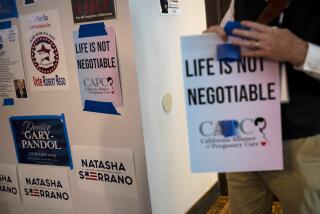Malls: free speech zones
- Share via
Political speech at retail shopping centers suffers from a brand-comparison weakness. Shoppers in a mall are accustomed to a dizzying range of choices: 31 flavors of ice cream, dozens of makes of digital cameras, scores of detergents. In American politics, you are almost always limited to two choices, and even those are frequently indistinguishable from each other.
So how do mall picketers and shopping center activists compete? In California at least, they get a little help from the state Supreme Court, which has ruled that the Fashion Valley Mall in San Diego cannot prevent protesters on its property from urging a boycott of one of its tenants. At issue was a 1998 incident during which picketers from the San Diego Union-Tribune began distributing leaflets inside the mall, describing their grievances against the newspaper and singling out the Robinsons-May store as a Union-Tribune advertiser. After about 15 minutes, mall officials arrived and removed the picketers to a public space outside the mall entrance.
Does a shopping mall have the responsibility to allow all reasonable public demonstrations?
Yes, according to long-standing California jurisprudence. Certainly, according to the venerable tradition of observing that shopping centers have replaced parks and public squares as civic gathering places. Not exactly, according to the U.S. Supreme Court and other state courts, which have been moving away from a 1970s-era position that owners of public-seeming spaces are required to grant their guests the same speech protections they would enjoy in fully public facilities. This month, the California Supreme Court bucked that national trend, extending its position that the rights of mall owners to regulate what gets said on their property are “worn thin by public usage.”
Justice Carlos R. Moreno, writing for the majority, negotiates a tangle of frequently contradictory state and federal rulings (just so you know, it turns on whether a clause in the mall’s voluminous permit application for demonstrators is sufficiently content-neutral), but he is guided by a sound instinct: Free speech goes where it wants to go, and those in positions of power, be they landlords or government officials, should regulate it only with extreme caution and reluctance.
The issue lies in how much power a mall actually has, and whether it enjoys any speech rights of its own. Before it is what Moreno calls a “public forum where people may reasonably exercise their right to free speech,” a mall is an apartment building for stores. Both the landlord and the tenants have rights and responsibilities in this arrangement -- among them the responsibility not to drive away business. No sensible mall owner would allow employees of the Apple store to demonstrate for a boycott of the Microsoft store. Why should that privilege apply to visitors, who aren’t even paying the rent on the place?
Moreno dismisses the potential financial losses to the mall and its tenants, and the mall has agreed to change its guidelines. But this latest decision may only defer reckoning with the question of how much one person may use another’s property as a forum for speech. Must a mall provide a soapbox for a competitor? Is any cause, no matter how vile, entitled to make its case on the steps of the cineplex?
In these conflicts, we tend to side with speech, in the conviction that freewheeling debate, in the park or in the mall, elevates us all. That’s hard to appreciate, though, if the front of your ice cream parlor has become a gathering place for the Ku Klux Klan.
Mall owners have not had much luck in the past with the argument that being forced to underwrite others’ speech entitles them to relief under the 5th Amendment’s takings provision, but that claim seems less wild when the speech is aimed directly at hurting their operations. There’s also a question of the expressive rights of property owners, because part of free speech is the right not to support expression you disagree with.
So while we applaud the court’s expansive speech protections, we suspect the real value of this decision may be in revealing the fault lines that exist between, and within, the rights of property and free expression. (We also mourn the loss of the Robinsons-May, which was acquired several years back and is now a Bloomingdale’s.)
More to Read
A cure for the common opinion
Get thought-provoking perspectives with our weekly newsletter.
You may occasionally receive promotional content from the Los Angeles Times.










